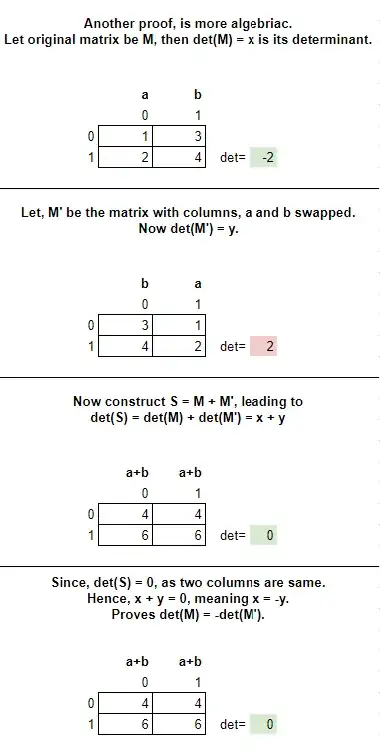It is a chicken and an egg kind of a problem if you think about it that way. All of the following ideas are connected to each other;
1- Swapping any 2 rows of a matrix, flips the sign of its determinant.
2- The determinant of product of 2 matrices is equal to the product of the determinants of the same 2 matrices.
3- The matrix determinant is invariant to elementary row operations.
4- Multiplying an entire row (or column) of a matrix by a constant, scales the determinant up by that constant.
If you assume any subset of these, the rest follow through.
I have used the elementary row operations and multiplying the entire row by a constant to show that the proof is quite straightforward.
Swapping 2 rows inverts the sign of the determinant.
For any square matrix you can generalize the proof of swapping two rows (or columns) being equivalent to swapping the sign of the determinant by using the axiom that the determinant is invariant under elementary row (or column) operations.
Consider a Matrix $\mathrm{A} \in \mathbb{F}^{n\times n} $ as shown below;
$$
\mathrm{A}=
\begin{bmatrix}
a_{11} & a_{12} & \cdots & a_{1n}\\
a_{21} & a_{22} & \cdots & a_{2n}\\
\vdots & \vdots & \ddots & \vdots\\
a_{n1} & a_{n2} & \cdots & a_{nn}\\
\end{bmatrix}
$$
Then the determinant of $\mathrm{A}$ is given by;
$$
\det{\mathrm{A}}
=
\begin{vmatrix}
a_{11} & a_{12} & \cdots & a_{1n}\\
a_{21} & a_{22} & \cdots & a_{2n}\\
\vdots & \vdots & \ddots & \vdots\\
a_{n1} & a_{n2} & \cdots & a_{nn}\\
\end{vmatrix}
$$
Consider two separate rows that you want to swap and add one of them to the other. W.L.O.G here assume that the first row is added to the second row. This holds in general for any 2 rows (or columns).
$Row 2 := Row 2 + Row 1$
$$
\det{\mathrm{(A)}}
=
\begin{vmatrix}
a_{11} & a_{12} & \cdots & a_{1n}\\
a_{21}+a_{11} & a_{22}+a_{12} & \cdots & a_{2n}+a_{1n}\\
\vdots & \vdots & \ddots & \vdots\\
a_{n1} & a_{n2} & \cdots & a_{nn}\\
\end{vmatrix}
$$
Next subtract the resulting row 2 from row 1.
$Row1 := Row1 - Row2$
$$
\det{\mathrm{(A)}}
=
\begin{vmatrix}
-a_{21} & -a_{22} & \cdots & -a_{2n}\\
a_{21}+a_{11} & a_{22}+a_{12} & \cdots & a_{2n}+a_{1n}\\
\vdots & \vdots & \ddots & \vdots\\
a_{n1} & a_{n2} & \cdots & a_{nn}\\
\end{vmatrix}
$$
Add the resulting Row 1 to Row 2.
$Row2 := Row2 + Row1$
$$
\det{\mathrm{(A)}}
=
\begin{vmatrix}
-a_{21} & -a_{22} & \cdots & -a_{2n}\\
a_{11} & a_{12} & \cdots & a_{1n}\\
\vdots & \vdots & \ddots & \vdots\\
a_{n1} & a_{n2} & \cdots & a_{nn}\\
\end{vmatrix}
$$
Take $-1$ common from the first row, this falls out of the determinant.
$$
\det{\mathrm{A}}
=
(-1)
\begin{vmatrix}
a_{21} & a_{22} & \cdots & a_{2n}\\
a_{11} & a_{12} & \cdots & a_{1n}\\
\vdots & \vdots & \ddots & \vdots\\
a_{n1} & a_{n2} & \cdots & a_{nn}\\
\end{vmatrix}
$$
Finally we have;
$$
\begin{vmatrix}
a_{11} & a_{12} & \cdots & a_{1n}\\
a_{21} & a_{22} & \cdots & a_{2n}\\
\vdots & \vdots & \ddots & \vdots\\
a_{n1} & a_{n2} & \cdots & a_{nn}\\
\end{vmatrix}
=
(-1)
\begin{vmatrix}
a_{21} & a_{22} & \cdots & a_{2n}\\
a_{11} & a_{12} & \cdots & a_{1n}\\
\vdots & \vdots & \ddots & \vdots\\
a_{n1} & a_{n2} & \cdots & a_{nn}\\
\end{vmatrix}
\quad \blacksquare
$$
The same argument holds for swapping any two rows (or columns).
